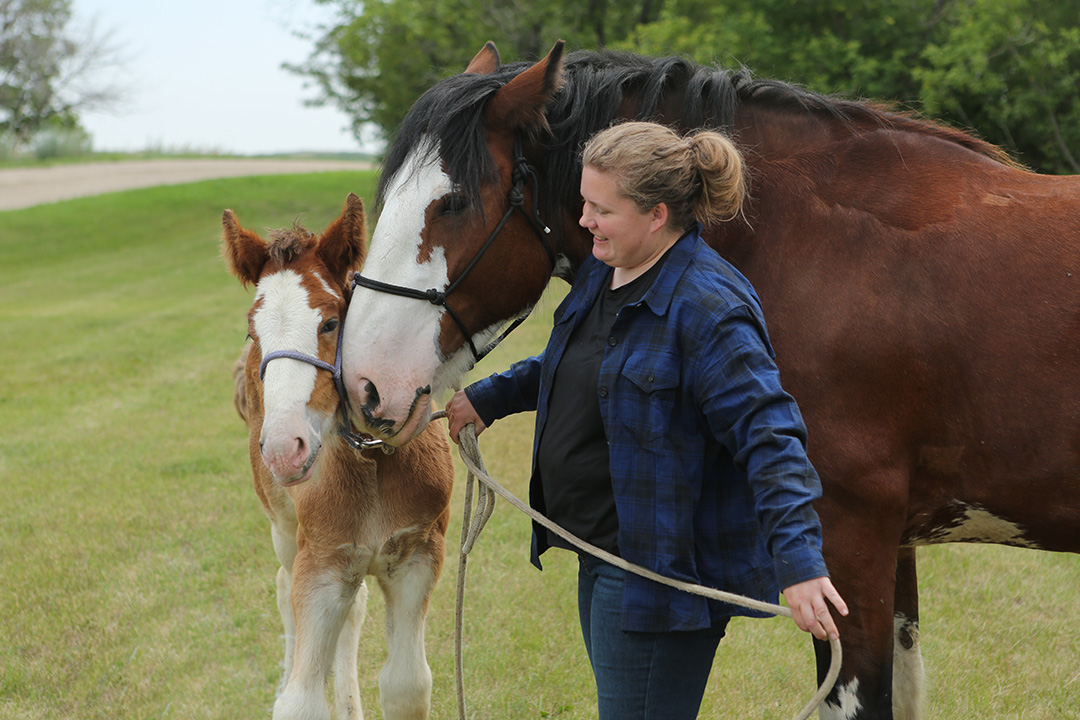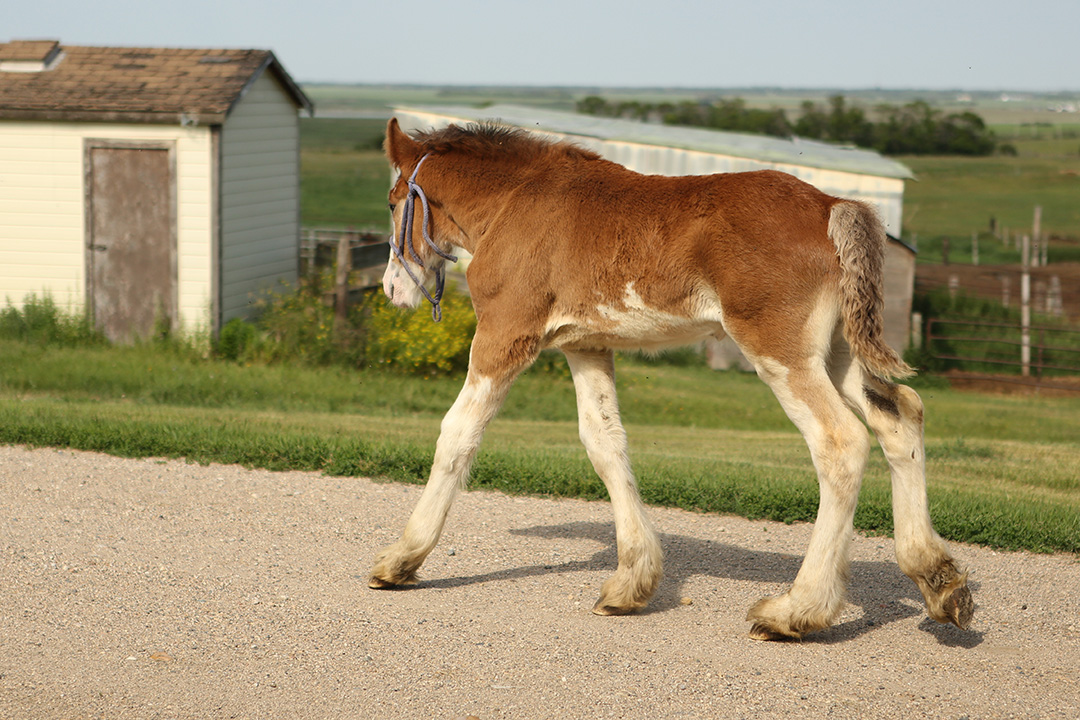
USask vet team’s herculean efforts save mare’s life
May 15, 2023, began as a day of celebration for Mikhaela Thrasher when her five-year-old purebred Clydesdale mare, Nya, gave birth to Hercules — a healthy, strapping colt that weighed a hefty 76 kilograms (168 pounds).
By Tyler SchroederThrasher had taken the day off from her job at the Western College of Veterinary Medicine (WCVM) so she could be on hand for Nya’s foaling at Hill Topper Clydesdales, a farm located 20 minutes east of Saskatoon, Sask.
Both the mare and foal seemed to be doing well after the birth, but about six hours later, Nya’s condition was deteriorating.
“I noticed Nya was in some discomfort after the birth. She hadn’t passed her afterbirth, so I’d been in contact with my veterinarian to discuss some things I should keep an eye on,” says Thrasher, a registered veterinary technologist (RVT). “My plan was to give her some time alone and head into town to pick up some pain medication.”
But plans quickly changed when Thrasher realized that Nya’s uterus had prolapsed —her uterus had turned inside out and was protruding out of her vagina. This serious disorder, which is very rare in horses, can happen immediately after or within a few hours of foaling. It’s often fatal due to complications such as infection, excessive bleeding or shock.
With Nya quickly losing blood and fighting for her life, Thrasher put in an emergency call to her colleagues at the WCVM and then put her training into action.
“[Waiting for the WCVM clinical team] felt like the longest 20 to 30 minutes of my life. I knew that I had to make sure Nya didn’t stand up because she would have bled out,” say Thrasher. “I kept grabbing fresh plastic sheets to place under her uterus to try to keep it as clean as possible.”
While equine field service clinician Dr. Maria Lopez (DVM) made her way to the east side of the city from another field call, a team from the WCVM’s equine theriogenology service — including a couple of senior veterinary students — gathered supplies and drove out to Hill Topper Clydesdales. Once they arrived, everyone worked quickly to stabilize Nya. She was started on intravenous fluid, painkillers and antibiotics while the team cleaned up the mare’s contaminated uterus.
“When we got there, the mare was down in shock. Her uterus, which is supposed to be inside her body, was outside and on the ground,” says Dr. Laura Hanni (DVM), a large animal clinical intern who was part of the team that responded to the emergency.
The team then had to physically replace the uterus back into Nya — no small task for four people working on a 680-kg (1,500-pound) Clydesdale mare.
“It was a big effort that proved to be very difficult. We did our best to position her safely and it took all four of us over an hour to put it [the uterus] back in place,” says Hanni.
Dr. Claire Card, a professor and specialist in equine theriogenology (reproduction) at the WCVM, was also part of the emergency team. Based on past experiences, she says that it takes a group effort to deal with uterine prolapses.
“When these huge prolapses occur, they always seem impossible to fix. You always need to stay calm and work as a team — and that’s what our team did,” says Card. “In the end, this really made all of the difference.”
“They finished putting the uterus back in and then the next big thing is, ‘Can she stand up?’” says Thrasher. Nya had been lying on the ground for nearly four hours, and because of her large size, there was concern that the mare would have nerve or muscle damage after being down for so long.
The well-being of the colt, Hercules, was another worry for the veterinary team.

“The first 12 hours are really critical because that’s when they obtain antibodies from the dam’s colostrum (first milk). We were very worried that the foal would get dehydrated,” says Card. She adds that they were also concerned whether the newborn foal had passed his meconium (the first feces) after birth.
Fortunately, Nya was able to get up and stand on her own. Once she was stable, the team loaded the mare and her foal into a horse trailer and transported her to the VMC’s Rae-Dawn Arabians Equine Intensive Care Unit (ICU) and Foal Centre.
The specialized centre, which is part of the veterinary teaching hospital, includes four stalls outfitted with oxygen lines, video monitoring and other tools for delivering specialized care. Two of the stalls are adjoining so a mare and her foal can be together during recuperation.
“This facility is critical in providing a biosecure area that is separate from the main large animal hospital. We have our own storage space and isolation from the busy large animal clinic, so it really makes our work more efficient,” says Card.
Dr. Chris Clark, a member of the VMC’s large animal medicine service, was part of the team that cared for Nya and Hercules once they arrived at the VMC.
“I arrived [back at the WCVM] expecting the worst, and to be honest with you, the work that our reproductive service and field service teams did in the field was unbelievable,” says Clark, who believes Nya had lost about half of her blood volume during the uterine prolapse.
“This mare was actually in way better shape than I anticipated. That’s not to say that she wasn’t still at risk — but they had literally performed miracles in the field.”
After several days of intensive care in the hospital, Nya’s condition gradually improved until she was well enough to return home alongside her foal. Based on her own experience, Thrasher stresses the importance of horse owners relying on veterinary professionals for their guidance and expertise during foaling.
“Don’t just assume everything is fine once the foal is on the ground. Keep a close eye on your mares well after they’ve foaled and keep your vets informed on what you’re seeing.”
With Nya making a full recovery after her ordeal, Thrasher praises her colleagues’ calm and swift response to the stressful situation.
“They worked as a team, they communicated with each other, and everybody got it together. She [Nya] wouldn’t be here if they hadn’t organized everything as quickly as possible,” says Thrasher.
“Because she would have died from blood loss and/or a rupture of her uterus … and I would have been dealing with an orphaned foal.”
Vet Vlog is a series of short videos and stories highlighting some of the patients, clinical team members and community initiatives at the WCVM Veterinary Medical Centre. Click here to view more videos.
